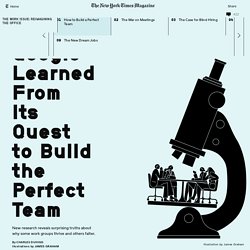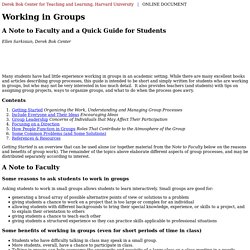

What Google Learned From Its Quest to Build the Perfect Team. So Rozovsky started looking for other groups she could join.

A classmate mentioned that some students were putting together teams for ‘‘case competitions,’’ contests in which participants proposed solutions to real-world business problems that were evaluated by judges, who awarded trophies and cash. The competitions were voluntary, but the work wasn’t all that different from what Rozovsky did with her study group: conducting lots of research and financial analyses, writing reports and giving presentations. The members of her case-competition team had a variety of professional experiences: Army officer, researcher at a think tank, director of a health-education nonprofit organization and consultant to a refugee program. Despite their disparate backgrounds, however, everyone clicked. They emailed one another dumb jokes and usually spent the first 10 minutes of each meeting chatting. It always struck Rozovsky as odd that her experiences with the two groups were dissimilar. Photo. The Power of Checklists. The Collaborative Challenge: Making Quality Decisions Together in the Age of Complexity.
Just read this: Healthy Teams in 10 Easy Phrases « Random Thoughts from an Online Pastor. Dropmark brings dead simple collaboration into the cloud [invites] Every once in a while, there’s an app or product that comes out and blows everybody’s minds. Not long ago, Dropbox opened our eyes to how simple sharing and storing files in the cloud can be. Oak, a design studio based out of Brooklyn, NY, has been quietly working away on Dropmark, and released a teaser video (below) nearly a year ago. Finally, the time has almost come for the whole world to see the fruit of Oak’s labor, and rest assured, this product is so perfect and dead simple that it just might knock you off your feet like Dropbox did.
Dropmark lets you drag and drop files and links from your desktop and Web browser to be instantly uploaded into collections in the cloud. Links from Vimeo, Flickr, YouTube, Soundcloud, Instagram, Google Maps and more are automatically recognized and understood, and there’s support for external apps like iPhoto. So, a place to save and share content with a fresh interface sounds interesting, but certainly isn’t ground-breaking. The Single Largest Collaboration-Killing Mistake You’re Unaware Of. There’s a lot of talk about how to get the most out of teams today. Do you define strict roles for each team member? Is it all about outlining the approach? Group cohesiveness. When discussing social groups, a group is said to be in a state of cohesion when its members possess bonds linking them to one another and to the group as a whole.

Although cohesion is a multi-faceted process, it can be broken down into four main components: social relations, task relations, perceived unity, and emotions.[1] Members of strongly cohesive groups are more inclined to participate readily and to stay with the group.[2] Definition[edit] There are different ways to define group cohesion, depending on how researchers conceptualize this concept. However, most researchers define cohesion to be task commitment and interpersonal attraction to the group.[3][4] Causes[edit]
The Eight Pillars of Innovation. Writing Guide: Working In Groups. Writing Guide: Email. An Introduction to Peer Review. Isites.harvard.edu/fs/html/icb.topic58474/wigintro.html. Derek Bok Center for Teaching and Learning, Harvard University | ONLINE DOCUMENT A Note to Faculty and a Quick Guide for Students Ellen Sarkisian, Derek Bok Center Many students have had little experience working in groups in an academic setting.

While there are many excellent books and articles describing group processes, this guide is intended to be short and simply written for students who are working in groups, but who may not be very interested in too much detail. It also provides teachers (and students) with tips on assigning group projects, ways to organize groups, and what to do when the process goes awry. Contents Getting Started is an overview that can be used alone (or together material from the Note to Faculty below on the reasons and benefits of group work).
Your Random Tidbits of Information are Key to Finding the Answer in Groups. How to win friends & influenence people by Dale Carnegie. Why Teamwork is Overrated. Does teamwork always enhance the performance of organisations?

It might seem like a question that’s too obvious to ask. Practically every job description ever written demands ‘a good team player’. Teams of all kinds pop up everywhere in organisations and the assumption is that they enhance organisational performance. In fact the evidence for the supposedly stupendous power of teams is pretty weak. Hundreds of studies have been carried out examining people’s performance in groups. Far from finding a huge boost to performance from teamwork, the studies are neutral or only show small benefits (Allen & Hecht, 2004). High performing groups are not normal, instead groups often have huge variations in ability from top to bottom.People in groups often waste time squabbling over goals.Groups frequently suffer downward performance spirals.
The message from the research is clear: the benefits of teamwork are nowhere near as clear as the fashion would suggest. Image credit: Thomas Cunningham. Effective Team Work & Collaboration. Online Tools for Group Projects.